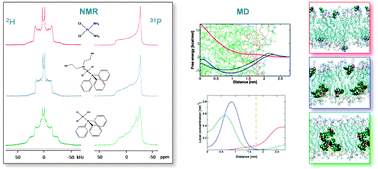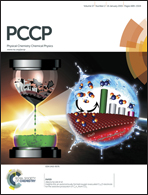Interaction of cisplatin and two potential antitumoral platinum(ii) complexes with a model lipid membrane: a combined NMR and MD study†
Abstract
In this study, the interaction of cisplatin (1) and two potential antitumoral Pt(II) complexes (2 and 3) with a model DMPC bilayer was investigated by multinuclear NMR spectroscopy and MD simulations in order to understand its implication for the different antitumoral properties shown by the three complexes. In particular, 31P, 13C and 2H solid state NMR experiments were performed to obtain information on the phase structure, phase transitions and structural and dynamic changes in the phospholipid bilayer upon interaction with the platinum complexes. On the other hand, MD calculations yielded free energy profiles for the different complexes across the bilayer; the results were analysed to obtain MD predictions on complex distribution with respect to the bilayer, as well as to establish their effects on the conformational equilibrium of the DMPC acyl chains. The combination of NMR and MD approaches highlighted that, whereas the more hydrophilic cisplatin tends to remain in the polar head group region causing a decrease in flexibility of the bilayer, the two new complexes enter into the bilayer. In particular, complex 2 is preferentially located relatively close to the surface, only slightly affecting the bilayer structure and mobility, while complex 3 penetrates more deeply, strongly perturbing the bilayer and giving rise to lateral phase separation.


 Please wait while we load your content...
Please wait while we load your content...